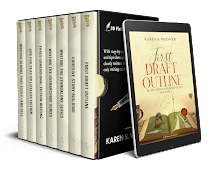Who Came First? {Astounding Advances in Electronic
Publishing}, Part 4
by Karen S. Wiesner
E-books and e-publishing have really advanced in the last three decades. When I first entered this arena in 1998, e-books were the ugly stepsister of "real books". Fast-forward thirty years, and it's a whole different world now than those early pioneering days in the industry. In the past three weeks, I posted previous sections of an article I wrote in 2003, when e-books and e-publishing still hadn't made much of an impact. Back then, universal acceptance of them always seemed out of reach. Reflecting on changes keeps history relevant. To that end, this week, I'm posting the final part.

WHO
CAME FIRST?
by Karen S. Wiesner
© 2003 as featured in ELECTRONIC
PUBLISHING The Definitive Guide, 2003 Edition by Karen S. Wiesner, published by
Hard Shell Word Factory OOP
Another
Brick in the Wall…
So where are we in e-publishing? The
beginning? The middle? What does the future hold?
I asked some of the earliest
e-publishers, given that they have such a long view of the medium, to share
their thoughts:
Nancy McAllister of C&M Online
Media, Inc.: "We had none of the tools years ago available in a practical
way for multimedia and other enhancements. Publishers today are doing a
wonderful job of using the technology. There is, however, sometimes to overuse
a good thing and the book being published can suffer from too much
technological attention.
"[What mass market publishers are
doing with e-books] doesn’t look right yet. We’ll have to wait and see what the
effect is of all that hype and motion on the core concept of online publishing.
All we can do now is observe.
"E-publishing is here, not only
for academic or informational books, but also for the general commercial
publisher who is disciplined, knowledgeable, professionally expert, and
patient."
Ray Hoy of The Fiction Works: "I
think [the fact that many small press e-publishers are now offering print
formats in the form of print-on-demand is] an evolutionary process. I think The
Fiction Works is a rare bird because we produce audiobooks, e-books and
paperbacks. Many of these little publishers will fall by the wayside. I’m sorry
to say that is already beginning to happen.
"[The future of e-publishing is]
going to be huge! Right now there’s very little money in e-publishing. We have
the advantage of being able to live on our audiobook and paperback sales, so we
can continue to pour money into e-book development. But believe me, the e-book
business is going to be simply enormous. I think that’s about a year away, but
when it starts to move, we’ll be ready and waiting."
Glenn Hauman of Bibliobytes: "I
recently got my hands on some numbers from a publisher (not me) showing the
sales of a book in hardcover and e-book formats. The hardcover sold in the
20,000 unit range. The e-book hadn’t sold 400. Not surprising to me—the e-book
was priced at the same price point as the hardcover—in fact, it was a nickel
higher. And being an e-book, there was no discount at the register, as there
was for the hardcover. We are now looking at the long-term endurance run in
this industry. The sprinters are dropping. The ones who are keeping their burn
rates low are staying around for the long haul out of sheer cussedness. They
survive the lean times because it’s always been lean times to them. But the big
publisher that spends millions on payroll for its e-publishing venture and
can’t crack a million in sales for 2000—well, it’s time to update the resume.
"E-publishing works, obviously.
Whether or not e-publishing for books works is still up in the air, but for
magazines it’s clearly more than arrived. I can’t think of a paper magazine
that doesn’t have an online component anymore. I’m beginning to think mandatory
licensing for texts may be coming down the pike, much the way radio does with
music.
"I don’t think there is an answer
which will allow the book industry to survive in anything even closely
resembling its current form. And I think that’s why they can’t find a solution.
Because most solutions leave them out of the game."
Bob Gunner of Cyber-Pulp Houston/USA:
"I dream every day that I will eventually develop a profitable and
acceptable way to get the words of writers to readers electronically. I know
that having a user-friendly and inexpensive reader device available and
manufactured by a company that supports the work of smaller e-publishers is the
way to do it."
Michael Hart of Project Gutenberg:
"The corporate structures have figured out they can make you buy new
copies of the same movie over and over as they plan the obsolescence of format
after format [U-Matic, Betamax, VHS, CD, DVD]. I think they will try to do the
same thing with books...so they would not think it was a bad
thing for such formats not to be used in the decades to come. I am
afraid that the only [format] likely to survive the coming decade intact is
HTML.
"[Mass market publishers] are
like kids fighting in a sandbox, which is appropriate since their corporate
ages do make them only kids in that respect, other than Microsoft. They
haven’t even reached adolescence yet...while Project Gutenberg moved out of adolescence
over 10 years ago. We have been doing Etexts for 30 years now, with no money,
but they still argue if it is feasible. If we had all the money they have spent
thinking about feasibility, we could have given away a trillion Etexts by
now!!!
"There are currently about 16,000
free Etexts to download, and about 22% or 3500 of them are from Project
Gutenberg. Ten years ago anyone would have been hard pressed to find more than
16 Etexts on the entire internet, and most, or all, of these would have been
Project Gutenberg Etexts—today there are 16,000—1,000 times as many as a decade
ago, and still growing at a fantastic rate—a rate, which if it is continued for
only another decade will yield 16,000,000 Etexts and the like to download free
via the internet. Ten years ago there were only a few million internet users to
download these Etexts, today there are hundreds of millions.
"[Speculation on the future of
e-publishing]: Big shake outs...some format takes over...then we see about
planned obsolescence."
John Galuszka of Serendipity Systems:
"With the exception of Martin Eberhard, the designer of the Rocket eBook,
most of the mass market publishers’ efforts and related hardware devices are
coming from the marketing departments, not the editorial and/or engineering
departments. What we have are mostly conventional books copied onto e-devices.
We are not seeing manuscripts being written to take advantage of the features
of the digital devices. Furthermore, they are pricing e-books as if they were
hardcover books. $25 for an e-book file of a bestseller conventional novel?
E-publishers don’t have to chop down forests for paper, buy ink by the barrel,
or even have to have warehouses and deal with remainders. E-books should be as
cheap or cheaper than paperbacks. High prices are alienating our potential
customers. Despite all the media hype, a viable market for electronic books
does not yet exist. No one is making money with this. We consider it to be a
good year when we break even.
"We need better, less expensive,
and open-system hardware, and we need lots of it. We were going in that
direction with the Rocket eBook. Prices of the device were slowly dropping,
memory upgrades were available, and best of all, it was very easy to publish
works for the Rocket eBook. If they could have gotten the price under $100 and,
for example, put a student’s textbooks into a package, this thing would have
sold millions. Instead, Gemstar killed it and substituted a more expensive,
closed-system device, the REB1100, with severely limited publishing
opportunities.
"On the software side, we are not
seeing writers who are adept at taking advantage of the features offered by
electronic publishing. Almost everything I see could exist on paper as easily
as in electronic form. Where are the Generation-X innovators? We had a brief
period of new genre development in the late 1980s. I hope we will have a new
wave soon. However, those writers should not be so dazzled by the digital glitz
that they lose sight of the fact that they must have a tight plot with
believable characters. The media may be digitally interactive hypertext, but we
are really still telling stories around the campfire with lurking, mysterious
shapes flitting about in the shadows beyond the light’s edge."
My thanks to the following
e-publishers who contributed to this article:
Bob Gunner of Cyber-Pulp Houston/USA,
John Cullen of Clocktower Books, Diane Greco of Eastgate Systems, Inc., Ray Hoy
of The Fiction Works, Marilyn Nesbitt of DiskUs Publishing, Lorna Tedder of
Spilled Candy Books, Stephen Ellerin of The Great American Publishing Society
(GR.AM.P.S.), Glenn Hauman of BiblioBytes, Nancy McAllister of C & M Online
Media, Inc., Sunny Ross of Mystic-Ink Publishing, John Galuszka of Serendipity
Systems, Mary Ann Heathman of LionHearted Publishing, Inc. and Michael S. Hart
of Project Gutenberg.
Special and a hundred-fold thanks to
Jamie Engle for forwarding me almost two years’ worth of archives of eBC’s ePub
Market Update.
Sources used
in this article:
ELECTRONIC PUBLISHING The Definitive
Guide, 1999 Edition by Karen S. Wiesner, published by Petals of Life OOP
ELECTRONIC PUBLISHING The Definitive
Guide, 2000 Edition by Karen S. Wiesner, published by Avid Press, LLC OOP
ELECTRONIC PUBLISHING The Definitive
Guide, 2002 Edition by Karen S. Wiesner, published by Avid Press, LLC OOP
ELECTRONIC PUBLISHING The Definitive
Guide, 2003 Edition by Karen S. Wiesner, published by Hard Shell Word Factory OOP
eBC’s E-Pub Market Update™, April 10,
1999; eBC’s E-Pub Market Update™, September 13, 1999 Volume 1, Issue No. 8;
eBC’s E-Pub Market Update™, November 5, 1999 Volume 1, No. 11; eBC’s E-Pub
Market Update™, November 9, 1999 Volume 1, No. 11; eBC’s E-Pub Market Update™,
December 08, 1999 Volume 1, No. 16; eBC’s ePUB MARKET UPDATE™, February 20,
2001 Volume 3, No. 02; eBC’s ePUB MARKET UPDATE™, April 5, 2001 Volume 3, No.
03; eBC’s ePUB MARKET UPDATE™, January 19, 2000 Volume 1, No. 19; eBC’s ePUB
MARKET UPDATE™, February 20, 2001 Volume 3, No. 02; eBC’s ePUB MARKET UPDATE™,
May 22, 2000 Volume 1, No. 26; eBC’s ePUB MARKET UPDATE™, September 20, 2000
Volume 2, No. 07
"The digital future is now:
Pocket Books to release KNOCKDOWN in e-Book and on-demand formats prior to
publication," July 19, 1999
"STEPHEN KING AND SIMON &
SCHUSTER TO PUBLISH NEW STORY EXCLUSIVELY ON EBOOK," New York, March 8,
2000
The Plant Income/Expense Report Through
12/31/00
Books@Random Divisional Information,
September 2000
Discover Modern Library eBooks, 2000
AtRandom, About Us, 2000
"TEXTERITY ENTERS INTO eBOOK
CONVERSION AGREEMENT WITH PENGUIN PUTNAM," Southborough, MA, and New York,
NY, November 15, 2000
"PENGUIN PUTNAM, LIGHTNING SOURCE
ENTER INTO STRATEGIC ALLIANCE
Lightning to Provide Digital Fulfillment
Services, Ensuring Secure E-Book Delivery," Nashville, TN, and New York,
NY, August 22, 2000
"Women.com Networks and Harlequin
Launch Site for Romantics," SAN MATEO, Calif., February 14, 2000
"SIMON & SCHUSTER TO PUBLISH
FIRST FULL SEASON OF eBOOKS Fall 2000 List Highlights Original and Simultaneous
ePublications from Major Authors and Franchises," August 23, 2000
"SIMON & SCHUSTER TO PUBLISH
ALL-NEW STAR TREK® NOVELS IN eBOOK ONLY," New York, August 8, 2000
"THOMAS NELSON, INC. BECOMES
FIRST CHRISTIAN PUBLISHER TO LAUNCH MAJOR E-BOOK PUBLISHING PROGRAM,"
October 6, 2000
"Holtzbrinck, Lightning Source
Create Global Digital Content Alliance Digital Fulfillment Company to
Provide Full Range of Services to Publisher Worldwide," New York, NY,
and La Vergne, TN, August 3, 2000
"About iPublish," 2001
"E-Publishing: Threat, Phantom or
Menace?" by Glenn Hauman, The Bulletin of the Science Fiction Writers of
America, Winter 1999
"E-Publishing: The Drawing of the
Long Knives in which we discuss the problems with locking up imaginary
things," by Glenn Hauman, The Bulletin of the Science Fiction Writers of
America, Summer 2001
"E-Publishing: Freebooting
Rebooting in which we discuss press deadlines, precognition, piracy, plunder
and profitability," by Glenn Hauman, The Bulletin of the Science Fiction
Writers of America, Fall 2000
"HISTORY AND PHILOSOPHY OF
PROJECT GUTENBERG," © August 1992
For those who believed in this medium right from the beginning, you were ahead of your time, and kudos for your fortitude and contribution to making history! It's a new day. Look how far we've come.
Karen Wiesner is an award-winning,
multi-genre author of over 150 titles and 16 series.
Visit her website here: https://karenwiesner.weebly.com/
and https://karenwiesner.weebly.com/karens-quill-blog
Find out more about her books and see her art here: http://www.facebook.com/KarenWiesnerAuthor
Visit her publisher here: https://www.writers-exchange.com/Karen-Wiesner/




































